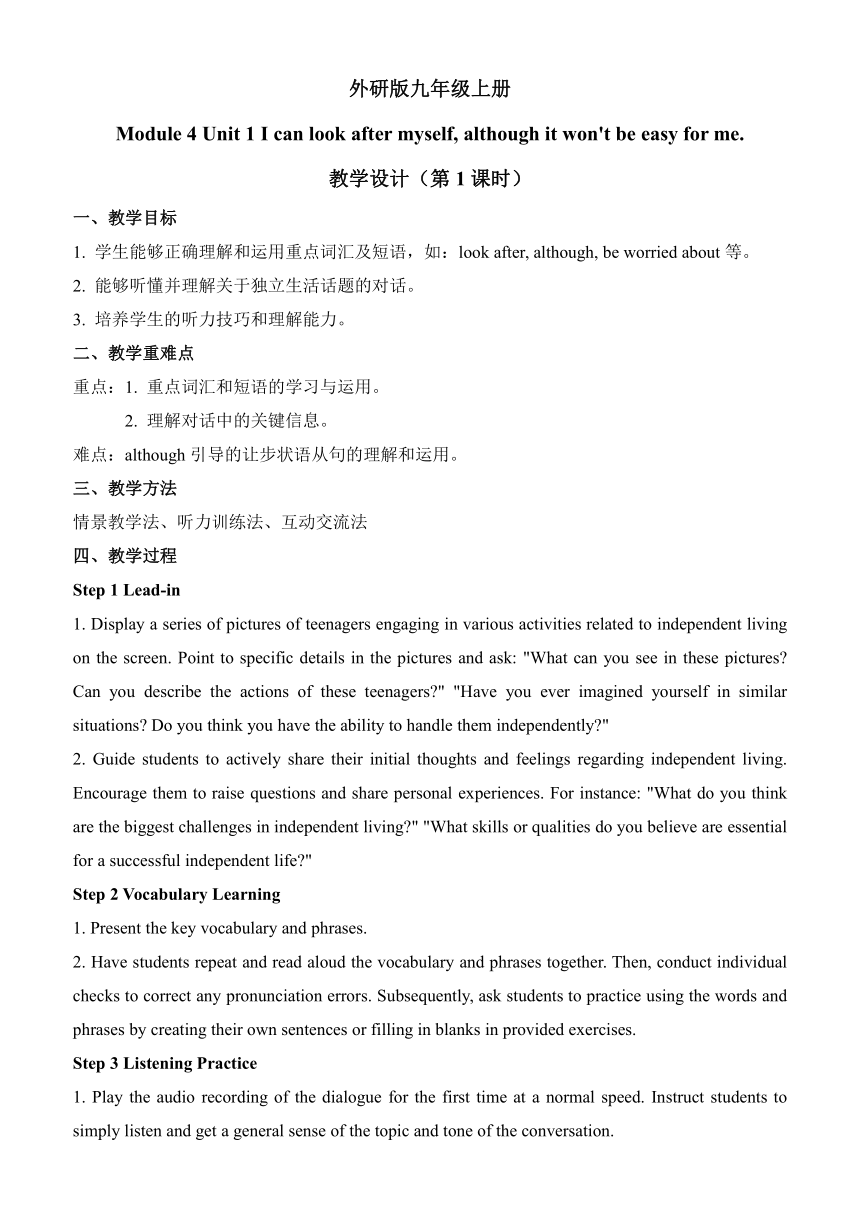
外研版九年级上册 Module 4 Unit 1 I can look after myself, although it won't be easy for me. 教学设计(第1课时) 一、教学目标 1. 学生能够正确理解和运用重点词汇及短语,如:look after, although, be worried about等。 2. 能够听懂并理解关于独立生活话题的对话。 3. 培养学生的听力技巧和理解能力。 二、教学重难点 重点:1. 重点词汇和短语的学习与运用。 理解对话中的关键信息。 难点:although引导的让步状语从句的理解和运用。 三、教学方法 情景教学法、听力训练法、互动交流法 四、教学过程 Step 1 Lead-in 1. Display a series of pictures of teenagers engaging in various activities related to independent living on the screen. Point to specific details in the pictures and ask: "What can you see in these pictures Can you describe the actions of these teenagers " "Have you ever imagined yourself in similar situations Do you think you have the ability to handle them independently " 2. Guide students to actively share their initial thoughts and feelings regarding independent living. Encourage them to raise questions and share personal experiences. For instance: "What do you think are the biggest challenges in independent living " "What skills or qualities do you believe are essential for a successful independent life " Step 2 Vocabulary Learning 1. Present the key vocabulary and phrases. 2. Have students repeat and read aloud the vocabulary and phrases together. Then, conduct individual checks to correct any pronunciation errors. Subsequently, ask students to practice using the words and phrases by creating their own sentences or filling in blanks in provided exercises. Step 3 Listening Practice 1. Play the audio recording of the dialogue for the first time at a normal speed. Instruct students to simply listen and get a general sense of the topic and tone of the conversation. 2. Play the recording a second time, pausing at key points or after each short segment. Present a set of carefully designed questions on the screen: "What specific problem is mentioned in the dialogue " "How does the main character plan to address the issue " "What emotions does the character express throughout the conversation " 3. After playing the recording for the second time, allow students a few minutes to think and jot down their answers. Then, initiate a class discussion to share and compare answers. Address any misunderstandings or difficulties collectively and explain the key listening strategies and techniques used to answer the questions. Step 4 Dialogue Comprehension 1. Divide students into groups of four or five. Distribute printed copies of the dialogue to each group and instruct them to read it aloud together, taking turns for each role. 2. Present a series of detailed questions related to the dialogue: "What details does the character provide about the problem " "Can you identify the reasons behind the character's feelings " "What suggestions or solutions are mentioned by other characters in the dialogue " Encourage students to discuss and answer these questions within their groups, refe ... ...
~~ 您好,已阅读到文档的结尾了 ~~